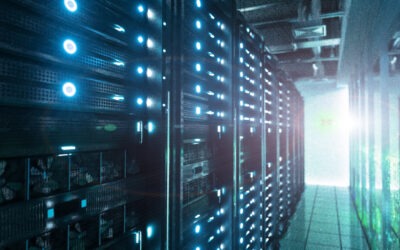Everyone needs to back up their computer data including things like documents, customer details and financial information to keep it safe from theft, fire or being accidentally deleted. And most small businesses, charities and other organisations also need an internet connection for their website and emails so they normally store their data on a simple server in their office.
A server is essentially a specialised computer the size of two pizza boxes connected to the business’ local network and usually the internet. It contains a set of hard disks that store data that can be sent out through the network to other local computers and to people visiting the business’ website via the internet. But as organisations demand for their product grows, staff need to store more data and the website becomes more popular. This means that they inevitably end up needing more servers. And eventually they have to build up an entirely separate server room just to house them all. But this isn’t straightforward to maintain.
For a start, lots of servers create lots of heat so they need to be kept cool otherwise they can fail catastrophically. And providing this level of cooling using traditional air conditioning units can be very expensive. In fact, current estimates suggest about 3% of the energy consumed by the entire world each year and 5% of Europe’s annual energy bill is spent on cooling computers.
Server facilities also need to be maintained around the clock by an IT professional to ensure they run reliably. Together these constraints can become a serious financial and logistical headache. Not to mention the security risk.
Why would I need a data centre?
Keeping business critical servers in-house is like a bank keeping its cash in a shed in the car park. Instead, many organisations now choose to move all of their servers out of their own buildings and into a specialist facility called a data centre.
This is a secure, computer friendly environment that is maintained around the clock by IT specialists, mechanical experts and electrical engineers, and kept at just the right temperature to ensure the servers perform at their best. Data centres are also equipped with their own back-up uninterruptible power supplies in the form of large batteries in a powerful generator. So even if there’s a mains electricity power failure the servers and the organisations they support can keep on running. And because this facility or location is shared by many organisations at once it is known as colocation.
What’s inside a data centre and how does it work?
The servers are held in locked cabinets or racks. Data centre clients will rent as many racks as they need, according to the amount of processing power, storage space and bandwidth that they use. The aisles between the racks are alternately hot, carrying the waste heat away from the servers and cold, fed by fresh, cooled air that’s driven through the racks to keep the servers at a constant computer friendly temperature.
Traditionally, air con units similar to the ones used in cars and homes have been used to supply the cold air needed to keep the server rooms cold. But these are very costly to run meaning that often as much electricity is consumed just keeping the facility cool as is used on running the servers themselves. In fact, for this reason the global data centre industry accounts for nearly as much carbon dioxide production as the airline industry every year.
More recently though the introduction of newer eco-friendly cooling techniques has enabled data centres to reduce the amount of electricity and carbon used in cooling by up to 90%, helping them to keep costs down for their clients. The new system uses the same science that keeps you cool when you exercise. While you sweat and the evaporation of the sweat carries away the heat from your skin, these cooling units evaporate water from wetted filters dropping the temperature of the passing air.
Why do I need a data centre?
So, if you’ve already got a computer room with all your servers in it why would you need a data centre? For some businesses popping their servers in a data centre may not be necessary. But many organisations are increasingly doing the sums and asking themselves:
- How much electricity and floor space would we save if we put all our servers in one location?
- How much would it cost if we needed to expand or reduce our current IT infrastructure in the future?
- And what would be the cost to the company if we lost our servers to a power cut, theft, fire or flood?
If the answer to any of the above is a lot than a data centre might be a better option.

